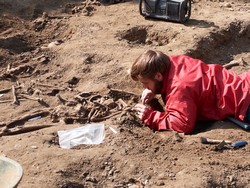New technique dates fossil teeth
The joint EU/Australian project HR_ESR (Developing high resolution electron spin resonance (ESR) dating of fossil teeth: contribution to the chronology of early hominid occupations in the Mediterranean area) investigated the physical and chemical processes that affect dental tissues at the micro scale and evaluated their impact on ESR age results. Researchers developed a high resolution combined Uranium-series ESR dating approach for fossil teeth. It was hoped that the results could explain why for a given site, some samples yield seemingly reliable results while others do not. This would help identify criteria for accurate evaluation of tooth samples via ESR dating. Samples were collected from different key Paleolithic sites in Spain and Israel. Researchers investigated the impact of incorporation of Uranium into dental tissue using high resolution laser ablation inductively coupled plasma mass spectrometry Uranium-series (ICP-MS U-series). Scientists studied the reliability and accuracy of ESR dose evaluation through the development of new analytical procedures for ESR measurements of enamel powder and fragments. The amount of data produced led to the development of specific data reduction procedures to extract useful information from all the analyses performed. This proved useful for understanding the nature and composition of the ESR signal of enamel, and for dating hominin remains that could not be powdered. Finally, the high resolution ESR dating approach was tested on a series of fossil tooth samples by combining high resolution laser ablation ICP-MS U-series analyses and ESR micro-dosimetry. The results provided vital information on ESR variability and U-series data within a given tooth, as well as among different teeth. From a geochronological perspective, the HR_ESR approach will improve the accuracy of the age estimates and provide new ESR dating results for some of the oldest archaeological sites in the Mediterranean basin. This will greatly improve our understanding of the first hominid settlements in this region as well as early hominin dispersal across Europe, Africa and Asia during the Pleistocene era.
Keywords
Fossil teeth, electron spin resonance, hominid, HR_ESR, laser ablation inductively coupled plasma mass spectrometry




